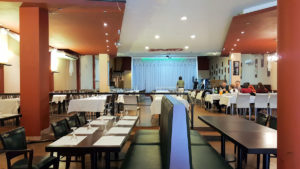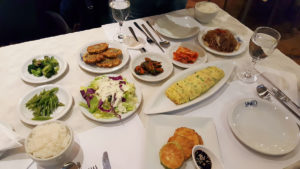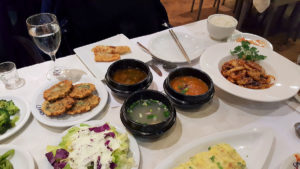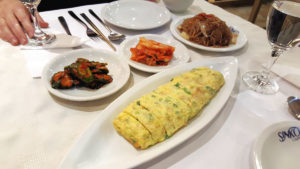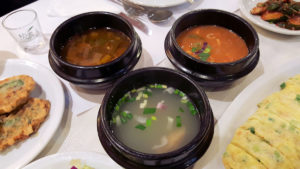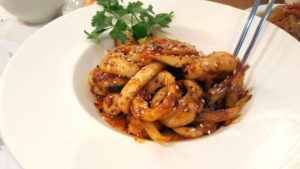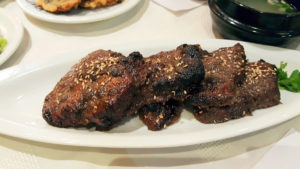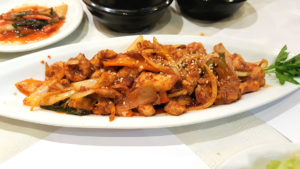There is a concept in Korean tradition called obangsaek, that refers to the “five classic colors”, each of which is also associated with a cardinal direction and an element….
- Blue – East – Wood
- Red – South – Fire
- Yellow – Center – Earth
- White – West – Metal
- Black – North – Water
This idea ran through my mind as I was heading to Sinko, Av. Rivadavía 7728, in Floresta, with the name being, it seemed, a play on the number five in Spanish, Cinco. Now, as to whether or not that was the thinking behind the naming of the place, I have no idea, I just made up the association between the name and the cultural concept, whole cloth. But I like it, and there was no one there to really ask, as the two older folk who seemed to be the owners sat sequestered in a corner of the restaurant, only punctuated when a teen in sleepwear and a hoodie wandered down from upstairs, clearly only moments out of bed, came down and joined them for a bite to eat and then headed back upstairs. I’m guessing the family lives up there….
The place is clearly more of an event salon than a restaurant, simply based on the way it’s setup. And, from their Facebook page, it looks like Korean weddings are pretty much their specialty. Oh, and note the presence of all five colors in the decor. I’m sticking with my surmise above. I’d contacted them a couple of weeks ago and they’d let me know that it was “reservations only, minimum of two adults for a fixed price menu at 410 pesos”. A trio of us met up for lunch yesterday.
I arrived about ten minutes early, and despite the obvious availability of tables, the waiter who let me in the door told me I’d have to wait until the others in my party were present before he would seat me. That’s just inhospitable in a setting like this. When one of my companions arrived, I asked again if we could sit, and he sort of sighed and agreed to let us sit and wait for the other person at the table. Give it a rest.
I’m not sure why… no that’s not true, it’s because every other fixed price place we’ve been to in the two Koreatowns has been… I thought it was Korean barbecue. But it’s not, it’s a mix of quite good ban chan and other small plates, and four “main dishes” – fish, shellfish, chicken, and beef. Plus three soups. They all come out pretty much as you have space on the table.
Excellent kimchi, both cabbage and cucumber versions, some of the better ones we’ve had on these ventures. Also a decent rolled omelette and japchae, stir-fried “glass noodles” made from sweet potato starch.
The soups are pretty basic – all good, but nothing outstanding.
The spicy shellfish, mostly calamari rings, has a mild kick, but great balance.
Some decent mini-steaks, crusted in traditional sweet and spicy and sesame bulgogi style, and tender as can be.
And, the spicy chicken – pretty much identical to the shellfish dish, but with a lot more onion in it.
Overall? The space, a bit cavernous and again, probably more suited to a big event than a casual restaurant. I imagine much of it is also simply that there were few other people there – when we arrived, there was the one table you can see in the top picture, later on two different couples and one other table of half a dozen arrived, but no more than that over the course of the couple of hours we were there. If the place had been fuller, it would have given some energy to the room, which most of the time was quiet as an empty church. Service, other than the being seated nonsense, was friendly and efficient. The food was uniformly good. No wows, but no disappointments either. It’s all you can eat, and we’d ordered extra plates of the two kimchis and some fried zucchini.
And, with the volatility of the Argentine peso, the price, upon receiving our bill, had jumped from the quoted 410 pesos to 480 pesos apiece (in less than two weeks). That’s been happening all around town, and I hadn’t asked to reconfirm the price when I made the reservation. Add in a large bottle of water (140 pesos), and a small bottle of soju (180 pesos), and a couple of coffees (actually, no charge for those, and the first place we’ve been offered coffee in a Korean restaurant other than Kyopo), plus tip, and we settled out for 650 pesos apiece, around $22. Not my favorite of Korean spots, but one I’d happily eat at again.
